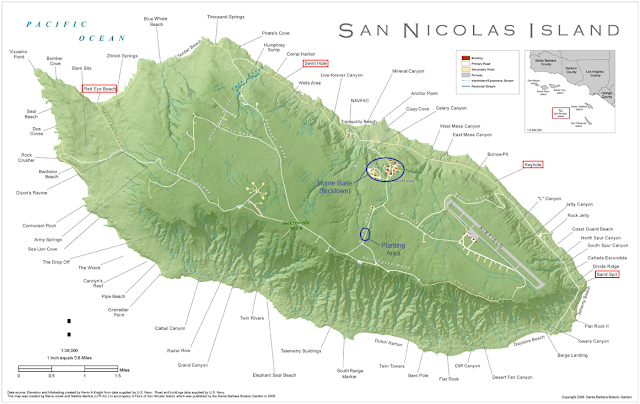Strange Little Worlds
I turned five years old in September 1969. It was just two months after the Apollo 11 moon landing and I was space-crazy, and my mom came up with the perfect birthday party game for me. She got a bunch of leftover boxes from our local grocery store, cut holes in the bottoms for us kids to stick our legs through, and decorated them to look like spaceships. Then she decorated the back yard with signs for the moon and the planets. At the party, we all ran around in our spaceships, going from one planet to another. It was great.
The California Channel Islands are kind of like that, a set of eight little worlds just off the coast, waiting for you to go out and visit them. Only one, Santa Catalina, has any permanent civilian communities on it. Two of them, San Nicolas and San Clemente, are military bases, although scientific and archeological research teams go there as well. (The real story behind the book, Island of the Blue Dolphins, took place on San Nicolas.) The other five - Anacapa, Santa Cruz, Santa Rosa, San Miguel and Santa Barbara - make up Channel Islands National Park, open to the public when conditions are favorable.
This past Saturday, as prepared as possible for the boat and eager to see some Island Foxes, I showed up at Channel Islands Harbor, ready for a day out on the largest of the islands, Santa Cruz. As we waited for our boat to cast off, a young woman came up to the bow where I was standing and asked me to take her picture with the harbor behind her. I later found out she was a Midwesterner staying in Ventura on business for two weeks. Rather than go to Hollywood or Disneyland or the usual tourist haunts, she wanted to see the California wilderness, and was especially hoping to see whales. On that count, she didn't have long to wait. We were barely five minutes out of the harbor when our boat slowed down for a mother gray whale and her calf making their way up the coast toward the Arctic. The mother kept them under the water as much as she could, but we did catch them surfacing a couple of times. Not long enough for me to get photos, but still worth seeing.
An hour later, we were on the island, and after listening to an overeager volunteer warn us about all the horrible things that could happen if we didn't watch out, I set off for El Montañon, a ridge that stretches across the National Park end of the island (the park only includes the eastern quarter of Santa Cruz, with the rest owned by the Nature Conservancy). I went through the campground and up out of Scorpion Canyon the way Emma and I had hiked back in last July, and it was amazing to see how much the formerly dry and dusty brown area had come to life. In some stretches, it was hard to find the trail. Once I got out of the canyon, the grass was more its usual golden brown color, but it was still taller and thicker than before. An hour or so later, I was at the northern end of the ridge, where I could look back toward the mainland, look east toward Anacapa Island, or look out west over the stretch of Santa Cruz parkland I had never seen before.

The ridge is full of knobby rocks covered in strange-colored moss, similar to what I've seen up on Tri-Peaks in the nearby Santa Monica Mountains, but in different colors. The trees up there are all covered in a strange, pale green moss, almost like lichen. I wasn't sure if it was a parasite or something that was supposed to be there.


I went all the way to the north end of the ridge, where a solar-powered relay station sits looking out over the ocean. From there, I could look down to Smuggler's Cove, where Emma and I went last July, easily recognized by the old grove of olive trees that were planted there a century or so ago. From that vantage point, Western Anacapa Island looks amazingly close by.


I would have loved to stay and explore more. I felt like I had enough energy to venture farther west, perhaps all the way to the Santa Cruz Island Pine trees near Chinese Harbor. But what I didn't have was time. I had to get back to Scorpion Anchorage in time to catch my boat, so the pines will have to wait for another time. On my way back down, I ran into a number of people heading up, including a large Boy Scout Troop. They were all camping overnight, so they didn't have my time constraints. I also came across a survey team, out planting little flags in the ground next to the little bits of junk from the ranching and oil drilling days, still scattered across the landscape.
I made it back to Scorpion Anchorage in plenty of time, running into the same woman I'd met on the boat ride out. She loved the island and was wondering where else she could go during her stay out here. Someone else had recommended the seal rookery in Carpinteria, which I enthusiastically agreed with, and then I added the Mishe Mokwa trail above Malibu. Do you suppose she went to either of them? I'll never know, but I hope she did.
As for me, I'm heading back to the mountains above Ojai on my next adventure, still working my way up to Topatopa Bluff next month. But I doubt it will be too long before I try venturing to the islands again.
The California Channel Islands are kind of like that, a set of eight little worlds just off the coast, waiting for you to go out and visit them. Only one, Santa Catalina, has any permanent civilian communities on it. Two of them, San Nicolas and San Clemente, are military bases, although scientific and archeological research teams go there as well. (The real story behind the book, Island of the Blue Dolphins, took place on San Nicolas.) The other five - Anacapa, Santa Cruz, Santa Rosa, San Miguel and Santa Barbara - make up Channel Islands National Park, open to the public when conditions are favorable.
This past Saturday, as prepared as possible for the boat and eager to see some Island Foxes, I showed up at Channel Islands Harbor, ready for a day out on the largest of the islands, Santa Cruz. As we waited for our boat to cast off, a young woman came up to the bow where I was standing and asked me to take her picture with the harbor behind her. I later found out she was a Midwesterner staying in Ventura on business for two weeks. Rather than go to Hollywood or Disneyland or the usual tourist haunts, she wanted to see the California wilderness, and was especially hoping to see whales. On that count, she didn't have long to wait. We were barely five minutes out of the harbor when our boat slowed down for a mother gray whale and her calf making their way up the coast toward the Arctic. The mother kept them under the water as much as she could, but we did catch them surfacing a couple of times. Not long enough for me to get photos, but still worth seeing.
An hour later, we were on the island, and after listening to an overeager volunteer warn us about all the horrible things that could happen if we didn't watch out, I set off for El Montañon, a ridge that stretches across the National Park end of the island (the park only includes the eastern quarter of Santa Cruz, with the rest owned by the Nature Conservancy). I went through the campground and up out of Scorpion Canyon the way Emma and I had hiked back in last July, and it was amazing to see how much the formerly dry and dusty brown area had come to life. In some stretches, it was hard to find the trail. Once I got out of the canyon, the grass was more its usual golden brown color, but it was still taller and thicker than before. An hour or so later, I was at the northern end of the ridge, where I could look back toward the mainland, look east toward Anacapa Island, or look out west over the stretch of Santa Cruz parkland I had never seen before.

The ridge is full of knobby rocks covered in strange-colored moss, similar to what I've seen up on Tri-Peaks in the nearby Santa Monica Mountains, but in different colors. The trees up there are all covered in a strange, pale green moss, almost like lichen. I wasn't sure if it was a parasite or something that was supposed to be there.


I went all the way to the north end of the ridge, where a solar-powered relay station sits looking out over the ocean. From there, I could look down to Smuggler's Cove, where Emma and I went last July, easily recognized by the old grove of olive trees that were planted there a century or so ago. From that vantage point, Western Anacapa Island looks amazingly close by.


I would have loved to stay and explore more. I felt like I had enough energy to venture farther west, perhaps all the way to the Santa Cruz Island Pine trees near Chinese Harbor. But what I didn't have was time. I had to get back to Scorpion Anchorage in time to catch my boat, so the pines will have to wait for another time. On my way back down, I ran into a number of people heading up, including a large Boy Scout Troop. They were all camping overnight, so they didn't have my time constraints. I also came across a survey team, out planting little flags in the ground next to the little bits of junk from the ranching and oil drilling days, still scattered across the landscape.
I made it back to Scorpion Anchorage in plenty of time, running into the same woman I'd met on the boat ride out. She loved the island and was wondering where else she could go during her stay out here. Someone else had recommended the seal rookery in Carpinteria, which I enthusiastically agreed with, and then I added the Mishe Mokwa trail above Malibu. Do you suppose she went to either of them? I'll never know, but I hope she did.
As for me, I'm heading back to the mountains above Ojai on my next adventure, still working my way up to Topatopa Bluff next month. But I doubt it will be too long before I try venturing to the islands again.



Comments